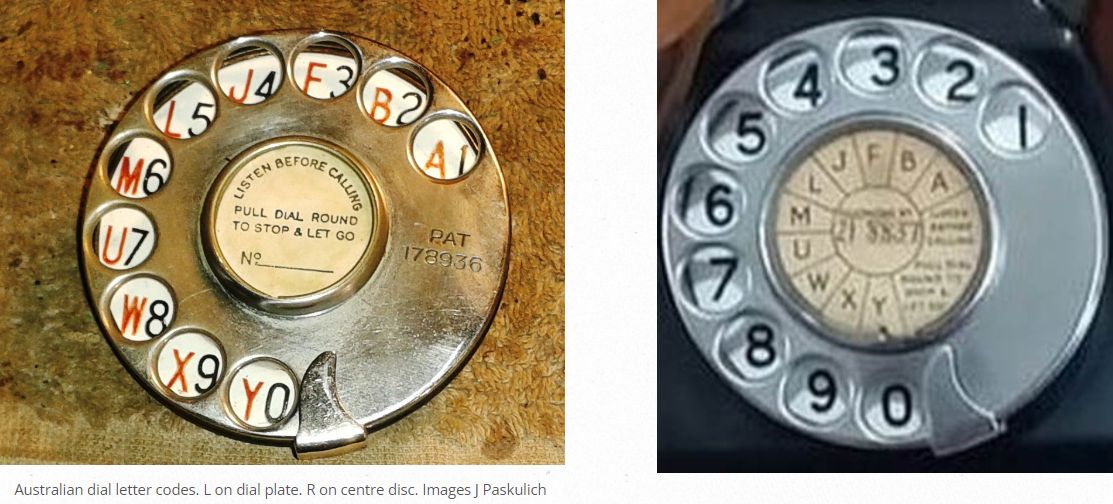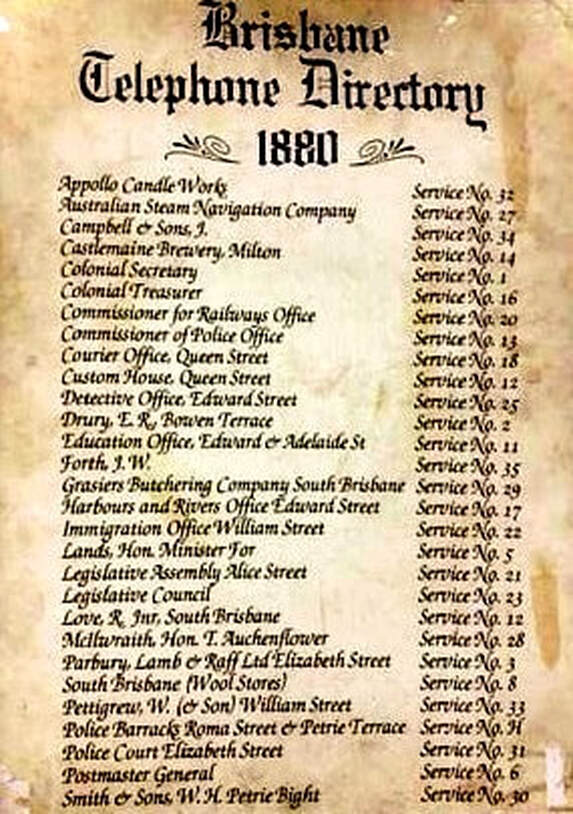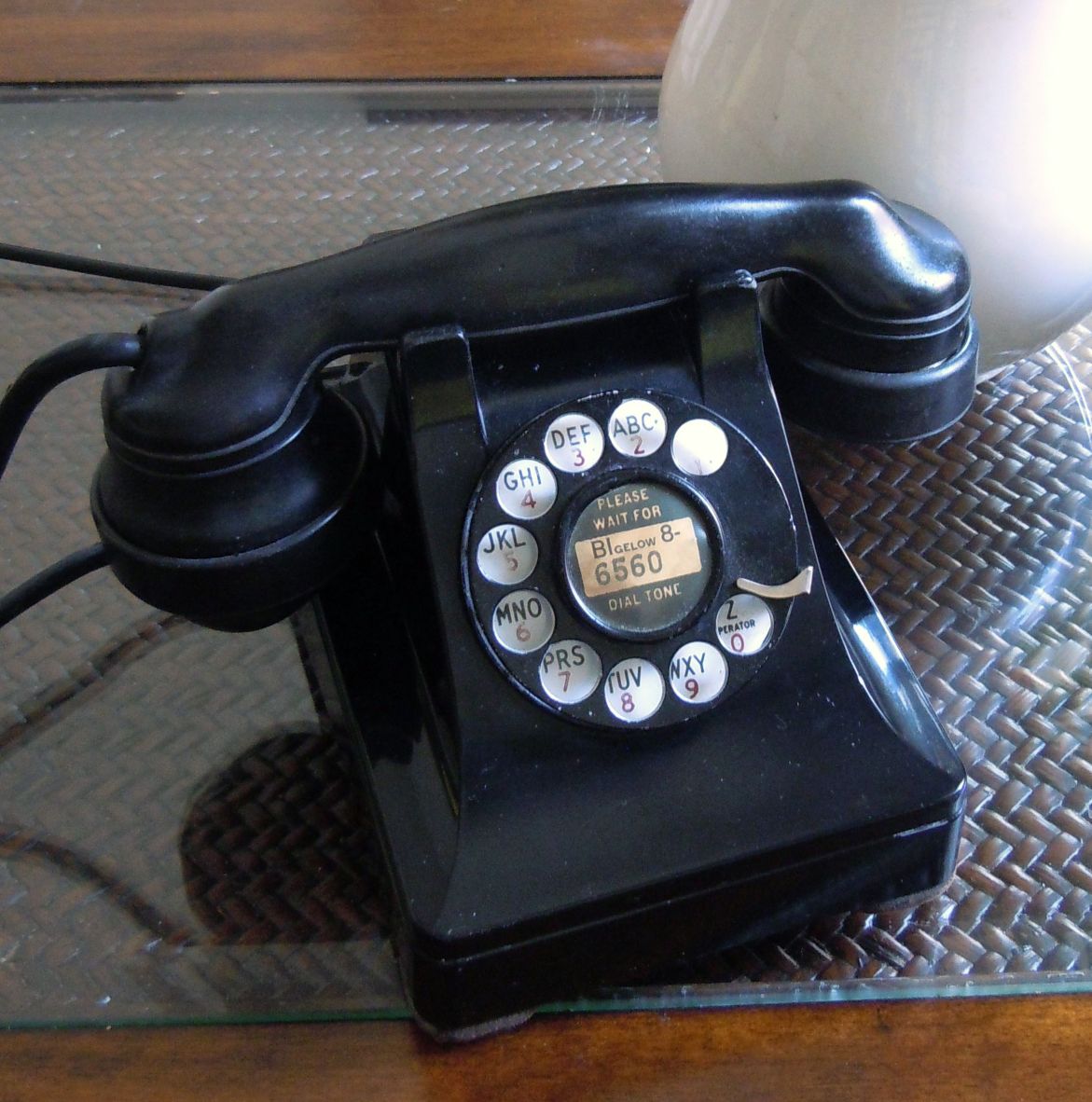- The First Local Telegraph
In 1854 the first short/long signalling Morse Code telegraph line was laid from Melbourne city to Williamstown. This was followed in South Australia with a line from Port Adelaide to Adelaide city in 1856. The first links between Melbourne to Adelaide and then Melbourne to Sydney were activated in 1858. Queensland’s first telegraph line was introduced in 1861 and connected to Sydney in the same year. At this time any messages crossing colonial borders were transcribed onto paper by an operator, transported across the border and then retransmitted. By 1861 there were 110 telegraph stations spread across the eastern colonies, using "inkers" and "sounders" and Wheatstone ABC "dials" for those unfamiliar with Morse code. Banks employed password codes for Telegraphic Transfers (TT).
- The First Overseas Telegraph
In November 1871 came the first overseas telegraph cable from London to Adelaide via Singapore, a submarine telegraph built by the British Australian Telegraph Company, founded by John Pender.
The Argus newspaper in Melbourne formed an association with The Sydney Morning Herald, contracting with the Reuters news agency in London for the regular transmission of news to Australia. This group successfully lobbied the Government of Victoria to pass the first copyright legislation of its kind in the world in 1871, protecting news material transmitted electronically for 24 hours from its first publication. In 1885, the two papers were joined by The Age in Melbourne, merging in 1895 into the Australian Press Association.
- The First Long Distance Telephone Call
In 1877, Alfred Barratt Biggs (1825-1900), telephoner and astronomer, is credited with making the first long distance telephone call in Australia between Campbell Town and Launceston Tasmania, an 80 kilometre distance.
In Brisbane in January 1878, Dr Severn successfully experimented with telephones over a mile of telegraph wire at the Electric Telegraph Office at the Brisbane GPO.
- The First Exchanges read more
In 1880 Scribner switchboards from US Western Electric installed in Melbourne and Brisbane, then Sydney in 1881. Early phones ran on batteries, and via a magneto handle on the phone, it dropped a shutter at the exchange, revealed a number, and rang a small bell. It was then connected via patch cords with plugs and spring jacks. Many lines privately owned. A private exchange opened in Collins Street Melbourne, a "trial line" in Pitt Street Sydney between Stock Exchange and GPO, then in October an exchange at the GPO in Queen Street Brisbane. The system was called the Edison-Bell loud speaking telephone.
Sydney's exchange (see more below) opened 1881-82, Hobart Launceston and Adelaide 1883, a toll line and exchange in Albion in Brisbane 1883-1884, then as Melbourne exchange (in Wills Street after 1884) reached 880 subscribers in 1887, it was purchased by Victorian Govt.
These first exchanges employed message boys to operate the equipment, however the boys quickly earned a reputation as inefficient, unruly and impertinent. In an effort to improve customer service they were replaced by women specifically employed for the job.
In 1885, Brisbane subscriber numbers reached 300. In 1889 when positions were advertised for 13 switch-board assistants at a salary of 10 shillings per week, 1671 young women applied. The new multiple switchboard cut over in 1890,
click here for photos. In 1895 subscribers reach 600 and a call for a specialist electrical engineer from abroad. Toowong exchange opened 1897, Ipswich opened underground lines 1899, Sandgate 1907.
More on Sydney
Early 1881, Sydney Herald reported that "telephonic communication" opened between the Stock Exchange and the Government's Railway Wool Sheds at Darling Harbour. Numerous lines became attached between wharves, wool-stores, etc. Following an accidental electrical fire later that year at a banquet at the exchange to demonstrate its powers, the GPO took over its management in 1882. The users erected their own "purchase lines" paying the entire cost plus an annual maintenance fee which lasted until December 1911.
In 1900, 30,000 telephone services were operating in Australia.
- On Federation in 1901, the Post Master General’s Department (PMG) was created to run Australia’s post and telecommunication services (Australian Post Office - APO). In December 1911, an Act of Parliament provided for PMG's acquisition of private lines. For most of the 20th century, the Australian telephone network was highly regulated and government owned. With limited exceptions e.g. Queensland State railways, telephone instruments were owned by the PMG/APO and rented to subscribers. It wasn't until the 1980s that restrictions eased and privately owned telephones appeared in any numbers.
- In 1902, an alternative telegraph route to the UK (and more economical)
 built from the Pacific Cable Station in Southport via Norfolk Island and Fiji and Fanning Island (part of Kiribati) to Vancouver Island, just off the mainland at Canada, linking to the UK and also to the US.
built from the Pacific Cable Station in Southport via Norfolk Island and Fiji and Fanning Island (part of Kiribati) to Vancouver Island, just off the mainland at Canada, linking to the UK and also to the US.
- In 1908 the dial tone, ring tone, and busy tone, first invented in Germany, were rapidly taken up by the British GPO and exchanges in Australia. Became important to telephone users when manual exchanges changed over to automatic, starting with Geelong in 1912.
- In 1909 the wireless company AWA Ltd formed in Sydney, becomes Australia's largest electronics and broadcasting organization.
- In 1911 a competitor to the Australian Press Association and Reuters' foreign newswire service was established. Called the United Cable Service, it initially served The Sun in Sydney and The Herald in Melbourne, and drew on the prestigious London paper The Times.
That same year, another exchange opened at Lonsdale Street in Melbourne for 9,000 subscribers, having 30 internal circuits for each line, in total 276,000 telephone jacks, the largest in Australia. Click here for the newspaper announcement. Wills Street Exchange lines were transferred incrementally.
- In 1911-1912 Brisbane and the capitals became Central Battery exchanges, though magneto phones in rural areas lasted till 1984.
 In 1912 the first automatic public telephone exchange opened in Geelong. In 1914 Newtown, Balmain, Glebe followed, in 1925 South Brisbane, click here for announcement in the Brisbane Courier. These automatic exchanges were based on a design patented by the Strowger Automatic Telephone Exchange Company in 1891. Used at independent exchanges in US, tested at Sydney GPO 1911, adopted London 1912, and finally AT&T Bell in US in 1919. Sydney city converted in 1927, Brisbane city in 1929. Not till after WW2 did Melbourne Central convert at Russell Street automatic exchange in 1954, becoming relay station for TV broadcasts. A new Lonsdale Street exchange opened in 1969.
In 1912 the first automatic public telephone exchange opened in Geelong. In 1914 Newtown, Balmain, Glebe followed, in 1925 South Brisbane, click here for announcement in the Brisbane Courier. These automatic exchanges were based on a design patented by the Strowger Automatic Telephone Exchange Company in 1891. Used at independent exchanges in US, tested at Sydney GPO 1911, adopted London 1912, and finally AT&T Bell in US in 1919. Sydney city converted in 1927, Brisbane city in 1929. Not till after WW2 did Melbourne Central convert at Russell Street automatic exchange in 1954, becoming relay station for TV broadcasts. A new Lonsdale Street exchange opened in 1969.
- In 1922 the Sydney-Brisbane telephone trunk line opened using thermionic repeaters i.e. vacuum tubes. These repeaters effected an enormous saving in copper by enabling a lighter wire to be used. Back in 1907 a trunk line between Melbourne and Sydney over a single pair of copper wires had carried a significant voltage through its signalling generator/equipment, 600 lb. weight per mile (170 kg per kilometre). Now 10 kg per kilometre.
- In 1924 Marconi successfully telephoned Australia from England on short-wave radio equipment. Within six months of its establishment, the British GPO's system of short-wave stations using Marconi's technology had taken 65 percent of the Eastern Telegraph group's business at a fraction of its cost.
That same year, Radio Stations (having "A" class and "B" class licenses) provide the means for government-owned and business-owned radio stations to seriously get under way in Sydney and Melbourne. They are followed by Brisbane and the Darling Downs in 1925.
- Also in 1925, three channels named as the "carrier wave" system, installed between Melbourne and Sydney, "enabling six separate conversations to be carried on between six different sets of people at one and the same time over the same wire".
 .
.
- In 1927 the alphanumeric rotary dial handset was launched by AT&T Bell for use on the US automatic exchange. Note the "O" for dialling operator (1223 in Australia), also the "1" that was used after 1951 for direct dialling a three digit area code outside user's respective plan ("0" in Australia).
- In 1929 Cable & Wireless formed as a merged holding company, owned 43.75 percent by Marconi's private shareholders and 56.25 percent by the Eastern Telegraph group.
- In 1930 Australia permanently linked to UK by radiotelephone, following many months of engineer testing by the British and Australian post offices, working with AWA.
- In 1933 the first private TTY (teletype) teleprinter at Stock Exchange in Melbourne hooked up to the Telegraph Office. It could punch out 8 typed messages simultaneously utilizing a **5 on/off pulses Baudot Code character with Stop (1½ pulses) Start (1 pulse) combined with paper tape transmission, faster than Morse. Released in New York by New Zealander Donald Murray in 1901 then used at Western Union, employed in Australia PMG after 1922.
** Called "bits" (binary digits) after 1948
- In 1935, Keith Murdoch (father of Rupert Murdoch) brokered a merger between the two foreign newswire competitors to cut down costs. It established the Australian Associated Press in Sydney as a not-for-profit cooperative with 14 newspaper shareholders. The AAP had an initial staff of 12, with a London and New York bureau.
- In 1946 after WW2, the Overseas Telecommunications Commission OTC is formed by the Commonwealth Government to oversee all overseas telecommunications services, inheriting its facilities and resources from AWA and Cable & Wireless.
- Prior to 1960, alpha prefixes of one or two characters were employed to establish a 6 character alphanumeric, though unlike the USA and Britain where the first two or three characters, say "TR" for Trafalgar, specified the exchange, in Australia the letters were employed randomly. See, for example, a 1947 newspaper announcement extract and images below.
Eight thousand Brisbane telephone numbers would be altered under a new re-routing plan to operate from April 1 next, the Postmaster-General's Department announced yesterday. Numbers affected are in the City. Valley. Camp Hill. Coorparoo. Mitchelton. Lutwyche. and Newmarket areas. New telephone number prefixes will be—L for certain Valley and City numbers. XW in Camp Hill. XU in Coorparoo, LL in Mitchelton. LU in Lutwyche. and LM in numbers in the 7000 and 8000 groups in Newmarket.
Click here for a 1927 Sydney Directory with Exchanges on Image 14.

In 1960 telephone numbers became 6 numeric digits, 7 from 1971, 8 by 1998.
- In 1954 Australia Telex an 80 customer teleprinter exchange (via an operator) in Melbourne & Sydney, used a five-digit number preceded by a two-letter country code, Australia was ‘AA’.
In 1959 Morse Code Telegraphs are auto switched to Telex by the exchange whenever possible. It winds down, last telegram in Sydney December 13 1962, letter-gram 1993.
- Also in 1959 Ericsson's Crossbar switching, installed in 1960 in Toowoomba, in 1971 Subscriber Trunk Dialling (STD) area codes, followed in 1976 by ISD (International Subscriber Dialling 0011 or a "+" prefix) with ISD installed through Australia by 1980.
- In December 1963 COMPAC connects Australia by cable telephone to Canada, and thus to the UK and Europe, via New Zealand and Honolulu. At the time it provided 80 two-way speech channels or 1,760 teleprinter circuits, as well as telegraph traffic, leased circuits for airlines, shipping companies and other commercial transmission. In 1967 OTC moves to Martin Place.
- Back to 1966. Telex automated on crossbar switching, linking to 100 overseas countries with about 4000 customers throughout Australia. It remained in use in Australia until the 1980s, when it was replaced by computer networks, fax, and email.
- In 1975 Telecom Australia created – the telephone division of the PMG with postal services split off into Australia Post.
- In January 1981 Rupert Murdoch purchases The Times (and Sunday Times) Newspapers in London.
- The First Internet Connection
 AARNet founded. On June 23 1989 at 56kbps the first TCP/IP (Internet) connection was opened by Dr Troben Nielsen at the University of Hawaii and Robert Elz at the University of Melbourne with subject line “Link Up”
AARNet founded. On June 23 1989 at 56kbps the first TCP/IP (Internet) connection was opened by Dr Troben Nielsen at the University of Hawaii and Robert Elz at the University of Melbourne with subject line “Link Up” 
- In June 1995 commercial assets sold to Telstra, who form Bigpond.
- In 1991 Optus formed as a private company in Australia by Cable & Wireless along with other companies, becoming a second telecommunications company to provide competition to Telecom Australia in wireless and landline services.
- In 1992-1993 OTC Overseas Telecommunications Commission merges with Telecom Australia, forming Telstra, its Head Office in Melbourne. Privatisation of Telstra commences in 1996, completed in 2006.
- Also in 1993 IANA Internet Assigned Numbers Authority issues the Asia-Pacific Network Information Centre (APNIC) with an initial 4 million IP addresses to allow it to become a regional IP address registry, using volunteer labour and donated facilities from a number of countries. Initially based in Tokyo.
- In 1997-1998 APNIC shifted from Tokyo to Brisbane. The four major Internet Service Provider (ISP) members are Telstra (since 1996), Optus (since 1998), Connect.com.au (since 1992), and Ozemail (which made its mark with Malcolm Turnbull as chairman 1994-1999).
In 1999 Connect.com.au was purchased in full by AAPT Australian Associated Press Telecommunications – owned by News Limited and John Fairfax, who sold it in 2000 to Telecom New Zealand.
- In 2005 Ozemail purchased by iiNet in Perth.
- In 2010 Telecom New Zealand sold AAPT's consumer business to iiNet.
- In May 2011 the ISP stats showed Telstra 4 million, Optus 2¼ million, iiNet 650,000, TPG 535,000, while in other stats, from Dec 2009 Vodafone had 318,000, Dodo 240,000, iPrimus 227,000.
- In 2013 TPG Telecom purchased AAPT as its wholesale and networks division.
- In 2015 TPG Telecom purchased iiNet.
- In 2020 TPG merged its resources with Vodafone Hutchison Australia (VHA). It followed announcement 30 Aug 2018.
- In June 2021 Australia stats showed 8 million households on fixed-line broadband, 5 million users on mobile broadband (with SIM cards in their modems, laptops, and tablets), and 27 million users on mobile phones / smartphones.
- In December 2023 NBN stats showed Telstra 3.55 million, TPG 1.85 million, Optus 1.1 million, Vocus (Dodo,iPrimus) 740,000, Aussie Broadband 720,000, Others 810,000.


 In 1912 the first automatic public telephone exchange opened in Geelong. In 1914 Newtown, Balmain, Glebe followed, in 1925 South Brisbane, click here for announcement in the Brisbane Courier. These automatic exchanges were based on a design patented by the Strowger Automatic Telephone Exchange Company in 1891. Used at independent exchanges in US, tested at Sydney GPO 1911, adopted London 1912, and finally AT&T Bell in US in 1919. Sydney city converted in 1927, Brisbane city in 1929. Not till after WW2 did Melbourne Central convert at Russell Street automatic exchange in 1954, becoming relay station for TV broadcasts. A new Lonsdale Street exchange opened in 1969.
In 1912 the first automatic public telephone exchange opened in Geelong. In 1914 Newtown, Balmain, Glebe followed, in 1925 South Brisbane, click here for announcement in the Brisbane Courier. These automatic exchanges were based on a design patented by the Strowger Automatic Telephone Exchange Company in 1891. Used at independent exchanges in US, tested at Sydney GPO 1911, adopted London 1912, and finally AT&T Bell in US in 1919. Sydney city converted in 1927, Brisbane city in 1929. Not till after WW2 did Melbourne Central convert at Russell Street automatic exchange in 1954, becoming relay station for TV broadcasts. A new Lonsdale Street exchange opened in 1969.
 .
.


 AARNet founded. On June 23 1989 at 56kbps the first TCP/IP (Internet) connection was opened by Dr Troben Nielsen at the University of Hawaii and Robert Elz at the University of Melbourne with subject line “Link Up”
AARNet founded. On June 23 1989 at 56kbps the first TCP/IP (Internet) connection was opened by Dr Troben Nielsen at the University of Hawaii and Robert Elz at the University of Melbourne with subject line “Link Up” 
